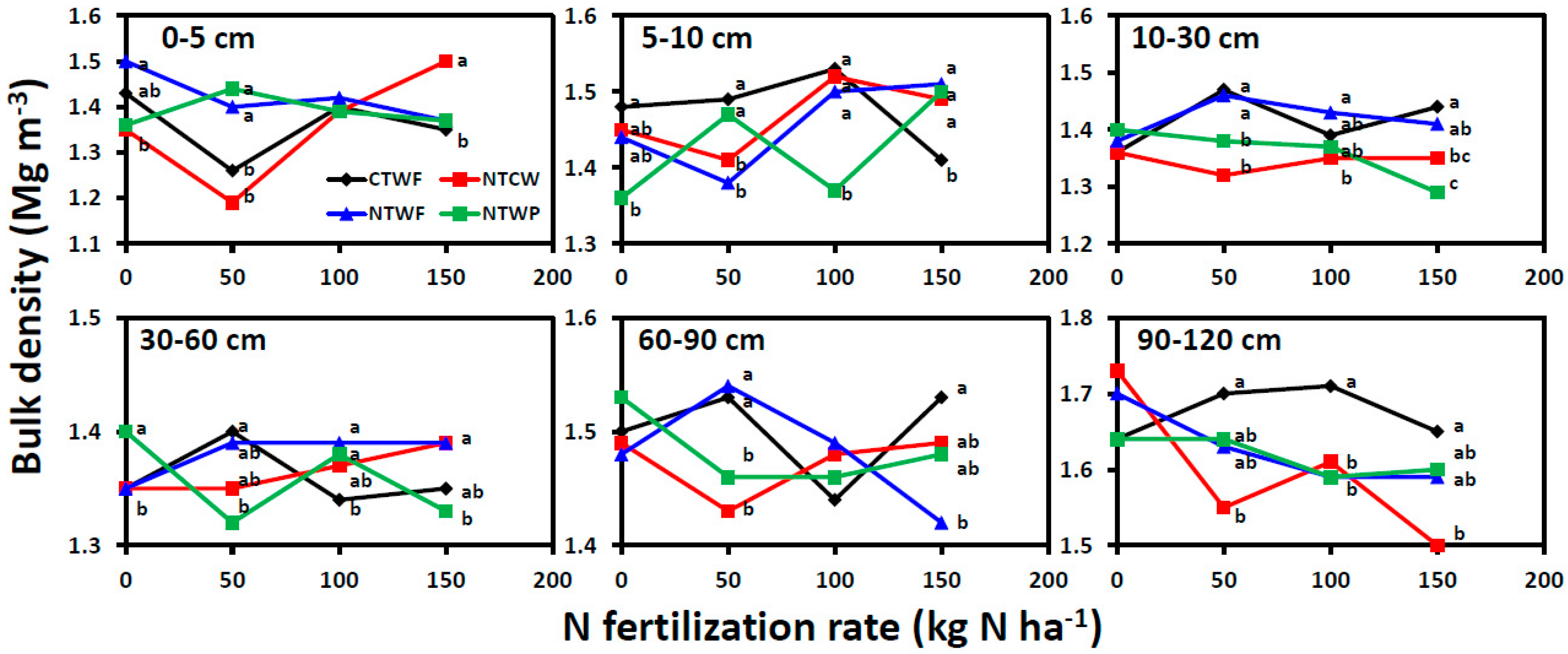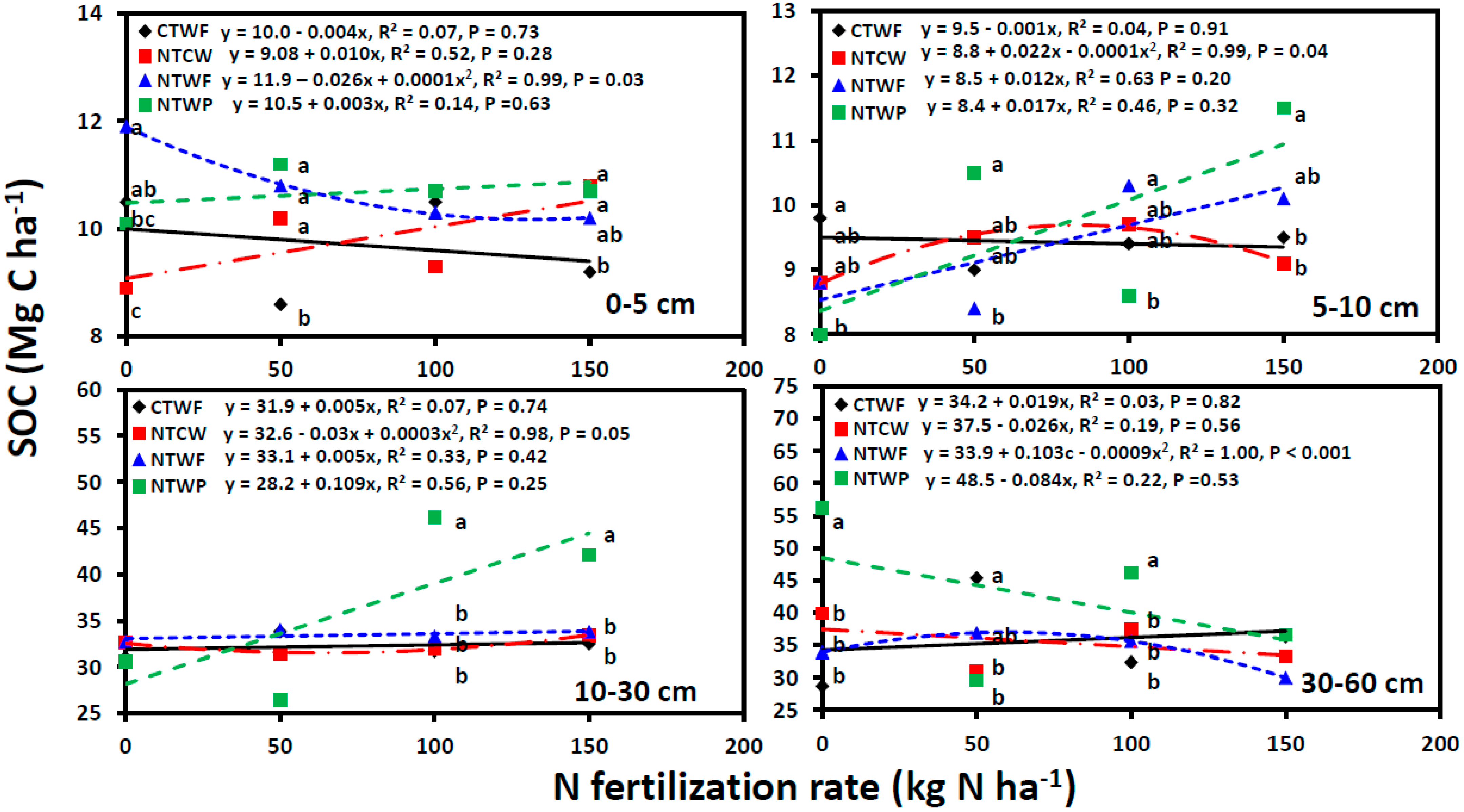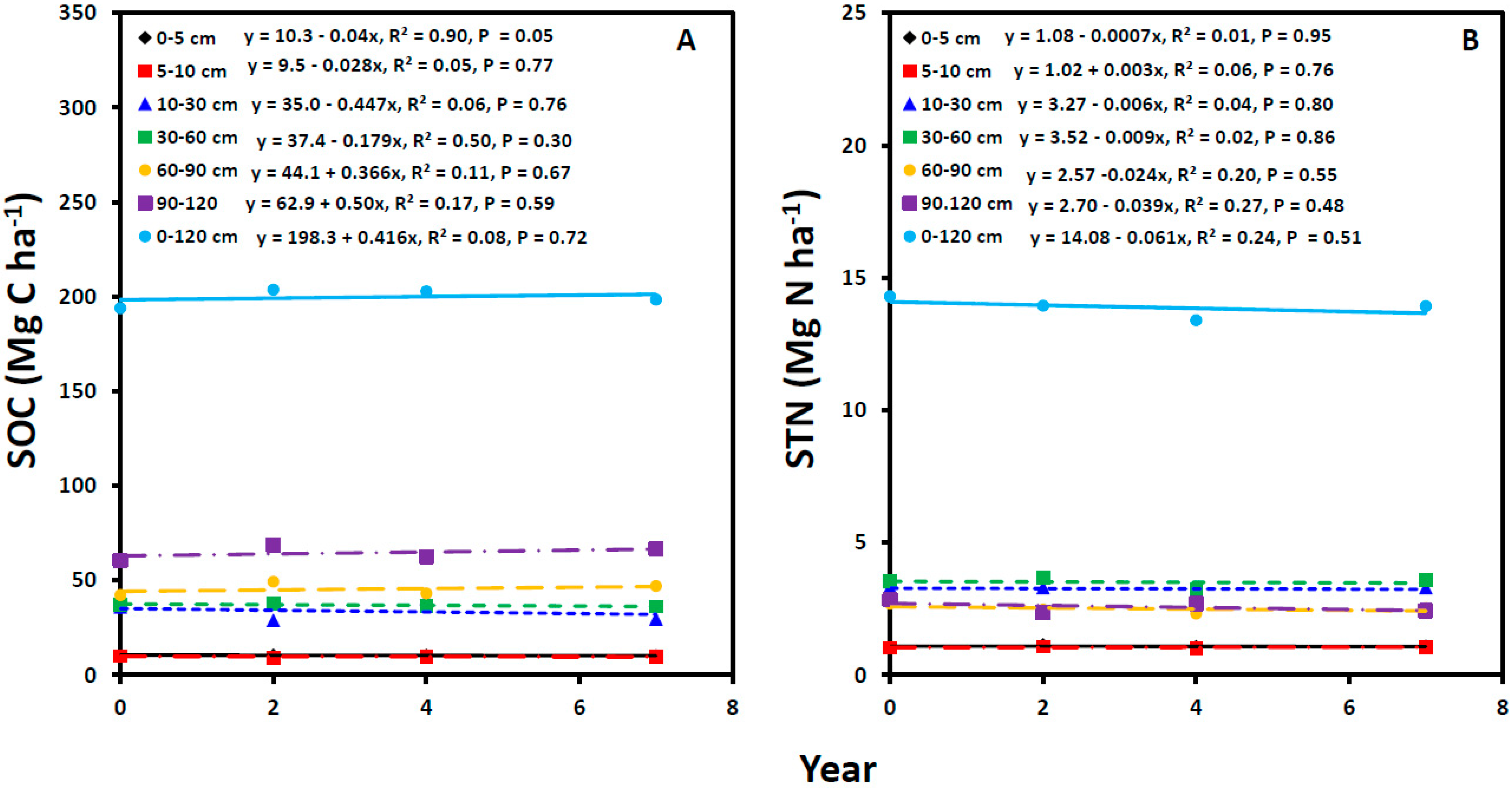Dryland Soil Carbon and Nitrogen Stocks in Response to Cropping Systems and Nitrogen Fertilization
Abstract
:1. Introduction
2. Materials and Methods
2.1. Experimental Details
2.2. Crop and Soil Sample Collection and Analysis
2.3. Statistical Analysis of Data
3. Results
3.1. Crop Residue Carbon and Nitrogen
3.2. Soil Bulk Density
3.3. Soil Organic Carbon
3.4. Soil Total Nitrogen
4. Discussion
4.1. Crop Residue Carbon and Nitrogen
4.2. Soil Organic Carbon
4.3. Soil Total Nitrogen
5. Conclusions
Funding
Data Availability Statement
Acknowledgments
Conflicts of Interest
References
- Paustian, K.; Andren, O.; Janzen, H.H.; Lal, R.; Smith, P.; Tian, G.; Tiessen, H.; van Noordwjik, M.; Woomer, P.L. Agricultural soils as a sink to mitigate CO2 emissions. Soil Use Manag. 1997, 13, 230–244. [Google Scholar] [CrossRef]
- Schlesinger, W.H. Biogeochemistry. In An Analysis of Global Change; Academic Press: San Diego, CA, USA, 1997. [Google Scholar]
- Mosier, A.R.; Halvorson, A.D.; Reule, C.A.; Liu, X.J. Net global warming potential and greenhouse gas intensity in irrigated cropping systems in northeastern Colorado. J. Environ. Qual. 2006, 35, 1584–1598. [Google Scholar] [CrossRef] [PubMed]
- Sey, B.K.; Whalen, J.K.; Gregorich, E.G.; Rochette, P.; Cue, R.I. Carbon dioxide and nitrous oxide content in soils under corn and soybean. Soil Sci. Soc. Am. J. 2008, 72, 931–938. [Google Scholar] [CrossRef]
- Sainju, U.M.; Caesar-TonThat, Y.; Caesar, A.J. Comparison of soil carbon dioxide flux measurements by static and portable chambers in various management practices. Soil Tillage Res. 2012, 118, 123–131. [Google Scholar] [CrossRef]
- United States Environmental Protection Agency (USEPA). Inventory of U.S. Greenhouse Gas Emissions and Sinks: 1990–2009; EPA 430-R-11-605; USEPA, Office of Atmospheric Programs: Dallas, TX, USA, 2011. [Google Scholar]
- Food and Agricultural Organization (FAO). Carbon Sequestration in Dryland Soils; World Soil Resources Report 102; FAO: Rome, Italy, 2004. [Google Scholar]
- Peterson, G.A.; Halvorson, A.D.; Havlin, J.L.; Jones, O.R.; Lyon, D.G.; Tanaka, D.L. Reduced tillage and increasing cropping intensity in the Great Plains conserve soil carbon. Soil Tillage Res. 1998, 47, 207–218. [Google Scholar] [CrossRef]
- Campbell, C.A.; Zenter, R.P.; Liang, B.C.; Roloff, G.; Gregorich, E.C.; Blomert, B. Organic carbon accumulation in soil over 30 yr in semiarid southwestern Saskatchewan: Effect of crop rotations and fertilizers. Can. J. Soil Sci. 2000, 80, 170–192. [Google Scholar] [CrossRef]
- Sainju, U.M.; Allen, B.L.; Caesar-TonThat, T.; Lenssen, A.W. Dryland soil carbon and nitrogen after thirty years of tillage and cropping sequence. Agron. J. 2015, 107, 1822–1830. [Google Scholar] [CrossRef]
- Morell, F.J.; Cantero-Martinez, C.; Lamporlanes, J.; Plaza-Bonilla, D.; Alvaro-Fuentes, J. Soil carbon dioxide flux and organic matter content: Effects of tillage and nitrogen fertilization. Soil Sci. Soc. Am. J. 2011, 75, 1874–1884. [Google Scholar] [CrossRef]
- Lopez-Bedillo, R.; Forton, M.J.; Lopez-Bedillo, F.J.; Lopez-Bedillo, R. Carbon sequestration by tillage, rotation, and nitrogen fertilization. Agron. J. 2010, 102, 310–318. [Google Scholar] [CrossRef]
- Black, A.L.; Tanaka, D.L. A conservation tillage cropping system study in the northern Great Plains of the United States. In Soil Organic Matter in Temperate Agroecosystems: Long-Term Experiments in North America; Paul, E.A., Ed.; CRC Press: Boca Raton, FL, USA, 1997; pp. 335–342. [Google Scholar] [CrossRef]
- Halvorson, A.D.; Wienhold, B.J.; Black, A.L. Tillage, nitrogen, and cropping system effects on soil carbon sequestration. Soil Sci. Soc. Am. J. 2002, 66, 906–912. [Google Scholar] [CrossRef]
- Aase, J.K.; Pikul, J.L., Jr. Crop and soil responses to long-term tillage practices in the northern Great Plains. Agron. J. 1995, 87, 652–656. [Google Scholar] [CrossRef]
- Sherrod, L.A.; Peterson, G.A.; Westfall, D.G.; Ahuja, A.R. Cropping intensity enhances soil organic carbon and nitrogen in a no-till agroecosystem. Soil Sci. Soc. Am. J. 2003, 67, 1533–1543. [Google Scholar] [CrossRef]
- Schmer, M.M.; Jin, V.L.; Wienhold, B.J.; Becker, S.M.; Varvel, G.E. Long-term rotation diversity and nitrogen effects on soil organic carbon and nitrogen stocks. Agrosyst. Geosci. Environ. 2020, 3, e20055. [Google Scholar] [CrossRef]
- Norton, J.B.; Mukhwana, E.J.; Norton, U. Loss and recovery of soil organic carbon and nitrogen in a semiarid ecosystem. Soil Sci. Soc. Am. J. 2012, 76, 505–514. [Google Scholar] [CrossRef]
- Obour, A.K.; Holman, J.D.; Simon, L.M.; Assefo, Y. No-tillage and nitrogen fertilization on soil chemical properties under dryland wheat-sorghum-fallow rotation. Agrosyst. Geosci. Environ. 2023, 6, e20330. [Google Scholar] [CrossRef]
- Zhao, G.; Bryon, B.A.; King, D.; Luo, Z.; Wang, E.; Song, X.; Yu, Q. Impact of agricultural management practices on soil organic carbon: Simulation of Austrian wheat systems. Glob. Chang. Biol. 2013, 19, 1589–1597. [Google Scholar] [CrossRef] [PubMed]
- Cao, B.; Qu, C.; Guo, X.; Liu, C.; Liang, C.; Jiao, Y.; Shi, J.; Tian, X. Long-term nitrogen and straw application improves wheat production and soil organic carbon sequestration. J. Soil Sci. Plant Nutri. 2022, 22, 3364–3376. [Google Scholar] [CrossRef]
- Rasmussen, P.E.; Rhode, C.R. Long-term tillage and nitrogen fertilization effects on organic nitrogen and carbon in a semiarid soil. Soil Sci. Soc. Am. J. 1988, 52, 1114–1117. [Google Scholar] [CrossRef]
- Jantalia, C.P.; Halvorson, A.D. Nitrogen fertilizer effects on irrigated conventional tillage corn yields and soil carbon and nitrogen pools. Agron. J. 2011, 103, 871–878. [Google Scholar] [CrossRef]
- Bremer, E.; Janzen, H.H.; McKenzie, R.H. Carbon, nitrogen, and greenhouse gas balances in an 18-year cropping system study on the northern Great Plains. Soil Sci. Soc. Am. J. 2011, 75, 1493–1502. [Google Scholar] [CrossRef]
- Melchiori, R.J.M.; Novelli, L.E.; Viviana, C.G.; Caviglia, O.P. Stover quality and soil organic carbon in long-term nitrogen-fertilized maize. Agron. J. 2014, 106, 1709–1716. [Google Scholar] [CrossRef]
- Ladha, J.K.; Reddy, C.K.; Padre, A.T.; van Kissel, C. Role of nitrogen fertilization in sustaining organic matter in cultivated soils. J. Environ. Qual. 2011, 40, 1756–1766. [Google Scholar] [CrossRef] [PubMed]
- Miles, R.J.; Brown, J.R. The Sanborn field experiment: Implications for long-term soil organic carbon levels. Agron. J. 2011, 103, 268–278. [Google Scholar] [CrossRef]
- Nafziger, E.D.; Dunker, R.E. Soil organic carbon trends over 100 years in the Morrow plots. Agron. J. 2011, 103, 261–267. [Google Scholar] [CrossRef]
- Kravchennko, A.N.; Robertson, G.P. Whole-profile soil carbon stocks: The danger of assuming too much from analyses of too little. Soil Sci. Soc. Am. J. 2011, 75, 235–2040. [Google Scholar] [CrossRef]
- Syswerda, S.P.; Corbin, A.T.; Mokma, D.J.; Kravchenko, A.N.; Robertson, G.P. Agricultural management and soil carbon storage in surface vs. deep layers. Soil Sci. Soc. Am. J. 2011, 75, 92–101. [Google Scholar] [CrossRef]
- Skadell, L.E.; Schneider, F.; Gocke, M.L.; Guigel, J.; Amelung, W.; Banke, S.L.; Siebert, S.; Honermeier, B.; Barkusky, B.; Hobley, E.U.; et al. Twenty percent of agricultural management effects on organic carbon stocks occur in subsoils: Results of ten long-term experiments. Agric. Ecosystem. Environ. 2023, 356, 108619. [Google Scholar] [CrossRef]
- VandenBygaart, A.J.; Bremer, E.; McConkey, B.G.; Ellert, B.H.; Angers, D.A.; Carter, M.R.; Drury, C.F.; Lafond, G.P.; McKenzie, R.H. Impact of sampling depth on differences in soil carbon stocks in long-term agroecosystem experiments. Soil Sci. Soc. Am. J. 2011, 75, 226–234. [Google Scholar] [CrossRef]
- Ellert, B.H.; Bettany, J.R. Calculation of organic matter and nutrients stored in soils under contrasting management regimes. Can. J. Soil Sci. 1995, 75, 529–838. [Google Scholar] [CrossRef]
- Littell, R.C.; Milliken, G.A.; Stroup, W.W.; Wolfinger, R.D.; Schabenberger, O. SAS for Mixed Models, 2nd ed.; SAS Institute Inc.: Cary, NC, USA, 2006. [Google Scholar]
- Box, J.E., Jr. Modern methods of root investigation. In Plant Roots: The Hidden Half, 2nd ed.; Waisel, Y., Eshel, A., Kafkafi, V., Eds.; Marcel Dekker: New York, NY, USA, 1996; pp. 193–237. [Google Scholar]
- Aase, J.K.; Schaefer, G.M. Economics of tillage practices and spring wheat and barley crop sequence in northern Great Plains. J. Soil Water Conserv. 1996, 51, 167–170. [Google Scholar]
- Sainju, U.M.; Caesar-TonThat, T.; Lenssen, A.W.; Evans, R.G. Dryland crop yields and soil organic matter as influenced by long-term tillage and cropping sequence. Agron. J. 2009, 101, 243–251. [Google Scholar] [CrossRef]
- Lenssen, A.W.; Johnson, G.D.; Carlson, G.R. Cropping sequence and tillage system influence annual crop production and water use in semiarid Montana. Field Crops Res. 2007, 100, 32–43. [Google Scholar] [CrossRef]
- Lenssen, A.W.; Sainju, U.M.; Jabro, J.D.; Iversen, W.M.; Allen, B.G.; Evans, R.G. Crop diversification, tillage, and management system influence spring wheat yield and water use. Agron. J. 2014, 106, 1445–1454. [Google Scholar] [CrossRef]
- Halvorson, A.D.; Reule, C.A. Irrigated no-till corn and barley response to nitrogen in northern Colorado. Agron. J. 2007, 99, 1521–1529. [Google Scholar] [CrossRef]
- Abeledo, L.G.; Calderini, D.F.; Slater, G.L. Nitrogen economy in old and modern malting barleys. Field Crops Res. 2008, 106, 171–178. [Google Scholar] [CrossRef]
- Power, J.F. Seasonal changes in smooth bromegrass top and root growth and fate of fertilizer nitrogen. Agron. J. 1988, 80, 740–745. [Google Scholar] [CrossRef]
- Heggenstaller, A.H.; Moore, K.J.; Liebman, M.; Anex, R.P. Nitrogen influences biomass and nutrient partitioning by perennial warm-season grasses. Agron. J. 2009, 101, 1363–1371. [Google Scholar] [CrossRef]
- Sainju, U.M. Tillage, cropping sequence, and nitrogen fertilization influence dryland soil nitrogen. Agron. J. 2013, 105, 1253–1263. [Google Scholar] [CrossRef]
- Sainju, U.M.; Stevens, W.B.; Caesar-Tonthat, T. Soil carbon and crop yields affected by irrigation, tillage, crop rotation, and nitrogen fertilization. Soil Sci. Soc. Am. J. 2014, 78, 936–948. [Google Scholar] [CrossRef]
- Liu, Z.; Sun, K.; Liu, W.; Gao, T.; Li, G.; Han, H.; Ning, T. Responses of soil carbon, nitrogen, and wheat and maize productivity to 10 years of decreased nitrogen fertilizer under contrasting tillage systems. Soil Tillage Res. 2020, 196, 104444. [Google Scholar] [CrossRef]








| Month | 2012 | 2013 | 2014 | 2015 | 2016 | 2017 | 2018 | 30-Year Average |
|---|---|---|---|---|---|---|---|---|
| January | 0 | 0 | 1 | 0 | 0 | 3 | 2 | 3 |
| February | 0 | 1 | 0 | 2 | 0 | 1 | 3 | 1 |
| March | 0 | 2 | 1 | 1 | 1 | 2 | 0 | 2 |
| April | 36 | 60 | 35 | 6 | 88 | 8 | 15 | 30 |
| May | 52 | 149 | 90 | 32 | 53 | 12 | 92 | 61 |
| June | 28 | 105 | 28 | 102 | 36 | 32 | 63 | 71 |
| July | 69 | 24 | 12 | 49 | 69 | 15 | 46 | 67 |
| August | 20 | 104 | 131 | 33 | 19 | 37 | 26 | 33 |
| September | 1 | 13 | 29 | 61 | 67 | 47 | 31 | 41 |
| October | 48 | 27 | 2 | 10 | 15 | 24 | 10 | 27 |
| November | 1 | 0 | 2 | 4 | 5 | 0 | 2 | 3 |
| December | 0 | 1 | 0 | 1 | 1 | 4 | 2 | 2 |
| April–August | 205 | 442 | 296 | 222 | 265 | 104 | 242 | 262 |
| January–December | 255 | 486 | 331 | 301 | 354 | 185 | 292 | 341 |
| Cropping System a | N Fertilization Rate (kg N ha−1) | Year | Crop Residue C (Mg C ha−1) | Crop Residue N (kg N ha−1) |
|---|---|---|---|---|
| CTWF | 0.81c b | 28.4c | ||
| NTCW | 1.11b | 38.2b | ||
| NTWF | 0.78c | 25.9c | ||
| NTWP | 1.25a | 51.1a | ||
| 0 | 0.85b | 28.7b | ||
| 50 | 0.99ab | 35.5a | ||
| 100 | 1.04a | 38.2a | ||
| 150 | 1.06a | 41.2a | ||
| 2012 | 0.71cd | 29.2cd | ||
| 2013 | 0.65d | 22.6d | ||
| 2014 | 1.14b | 33.2c | ||
| 2015 | 0.83cd | 49.8b | ||
| 2016 | 1.91a | 68.5a | ||
| 2017 | 0.90c | 31.1c | ||
| 2018 | 0.78cd | 2.70c | ||
| Significance | p values | |||
| Cropping system (C) | <0.001 | 0.003 | ||
| N fertilization rate (F) | <0.001 | 0.022 | ||
| C × F | 0.725 | 0.863 | ||
| Year (Y) | <0.001 | <0.001 | ||
| C × Y | 0.108 | 0.357 | ||
| F × Y | 0.970 | 0.999 | ||
| C × F × Y | 1.000 | 1.000 | ||
| Source | Depth Intervals | ||||||
|---|---|---|---|---|---|---|---|
| 0–5 cm | 5–10 cm | 10–30 cm | 30–60 cm | 60–90 cm | 90–120 cm | 0–120 cm | |
| p values | |||||||
| Bulk density | |||||||
| C | 0.339 | 0.338 | 0.079 | 0.488 | 0.873 | <0.001 a | ND b |
| F | 0.108 | <0.001 | 0.001 | 0.027 | 0.067 | <0.001 | ND |
| C × F | <0.001 | <0.001 | <0.001 | <0.001 | <0.001 | <0.001 | ND |
| Y | 0.587 | 0.680 | 0.237 | 0.158 | 0.328 | 0.327 | ND |
| C × Y | 0.729 | 0.719 | 0.725 | 0.357 | 0.425 | 0.482 | ND |
| F × Y | 0.751 | 0.523 | 0.329 | 0.289 | 0.720 | 0.702 | ND |
| C × F × Y | 0.251 | 0.925 | 0.357 | 0.998 | 0.921 | 0.805 | ND |
| SOC | |||||||
| C | 0.104 | 0.967 | 0.436 | 0.632 | 0.375 | 0.138 | 0.281 |
| F | 0.996 | 0.008 | 0.063 | 0.222 | 0.044 | 0.032 | 0.212 |
| C × F | 0.002 | <0.001 | 0.009 | <0.001 | 0.046 | <0.001 | 0.003 |
| Y | 0.836 | 0.131 | <0.001 | 0.940 | 0.034 | 0.091 | 0.516 |
| C × Y | 0.768 | 0.611 | 0.643 | 0.845 | 0.954 | 0.999 | 0.931 |
| F × Y | 0.995 | 0.767 | 0.830 | 0.994 | 0.987 | 0.909 | 1.000 |
| C × F × Y | 0.999 | 0.979 | 0.968 | 0.999 | 0.995 | 1.000 | 1.000 |
| STN | |||||||
| C | 0.533 | 0.802 | 0.282 | 0.515 | 0.406 | 0.270 | 0.671 |
| F | 0.942 | 0.004 | 0.092 | 0.045 | 0.602 | 0.712 | 0.173 |
| C × F | <0.001 | <0.001 | <0.001 | 0.026 | 0.014 | 0.016 | 0.027 |
| Y | 0.071 | 0.033 | 0.006 | <0.001 | <0.001 | 0.001 | 0.001 |
| C × Y | 0.793 | 0.965 | 0.927 | 0.812 | 0.160 | 0.098 | 0.290 |
| F × Y | 0.974 | 0.990 | 0.787 | 0.869 | 0.572 | 0.990 | 0.984 |
| C × F × Y | 1.000 | 1.000 | 0.989 | 0.970 | 0.857 | 0.963 | 0.999 |
Disclaimer/Publisher’s Note: The statements, opinions and data contained in all publications are solely those of the individual author(s) and contributor(s) and not of MDPI and/or the editor(s). MDPI and/or the editor(s) disclaim responsibility for any injury to people or property resulting from any ideas, methods, instructions or products referred to in the content. |
© 2024 by the author. Licensee MDPI, Basel, Switzerland. This article is an open access article distributed under the terms and conditions of the Creative Commons Attribution (CC BY) license (https://creativecommons.org/licenses/by/4.0/).
Share and Cite
Sainju, U.M. Dryland Soil Carbon and Nitrogen Stocks in Response to Cropping Systems and Nitrogen Fertilization. Environments 2024, 11, 70. https://doi.org/10.3390/environments11040070
Sainju UM. Dryland Soil Carbon and Nitrogen Stocks in Response to Cropping Systems and Nitrogen Fertilization. Environments. 2024; 11(4):70. https://doi.org/10.3390/environments11040070
Chicago/Turabian StyleSainju, Upendra M. 2024. "Dryland Soil Carbon and Nitrogen Stocks in Response to Cropping Systems and Nitrogen Fertilization" Environments 11, no. 4: 70. https://doi.org/10.3390/environments11040070
APA StyleSainju, U. M. (2024). Dryland Soil Carbon and Nitrogen Stocks in Response to Cropping Systems and Nitrogen Fertilization. Environments, 11(4), 70. https://doi.org/10.3390/environments11040070







